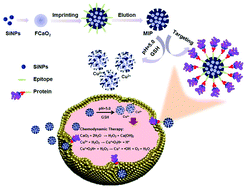H2O2 self-supplying degradable epitope imprinted polymers for targeted fluorescence imaging and chemodynamic therapy†
Abstract
Chemodynamic therapy (CDT), the ability to transform H2O2 into a highly toxic hydroxyl radical (˙OH) through a Fenton or Fenton like reaction to kill cancer cells, enables selective tumor therapy. However, the effect is seriously limited by the insufficiency of endogenous H2O2 in cancer cells. Additionally, the specific recognition of epitope imprinting plays an important role in targeting cancer cell markers. In this work, we prepared H2O2 self-supplying degradable epitope molecularly imprinted polymers (MIP) for effective CDT, employing fluorescent calcium peroxide (FCaO2) as an imaging probe and a source of H2O2, the exposed peptide in the CD47 extracellular region as the template, copper acrylate as one of the functional monomers and N,N‘-bisacrylylcystamine (BAC) as a cross-linker. MIP with recognition sites can specifically target CD47-positive cancer cells to achieve fluorescence imaging. Under the reduction of glutathione (GSH), the MIP were degraded and the exposed FCaO2 reacted with water to continuously produce H2O2 in the slightly acidic environment in cancer cells. The self-supplied H2O2 produced ˙OH through a Fenton like catalytic reaction mediated by copper ions in the MIP framework, inducing cancer cell apoptosis. Therefore, the MIP nano-platform, which was capable of specific recognition of the cancer cell marker, H2O2 self-supply and controlled treatment, was successfully used for targeted CDT.

- This article is part of the themed collection: 2021 Nanoscale HOT Article Collection


 Please wait while we load your content...
Please wait while we load your content...